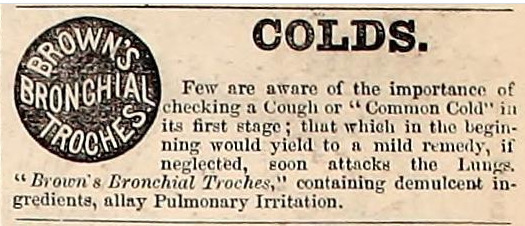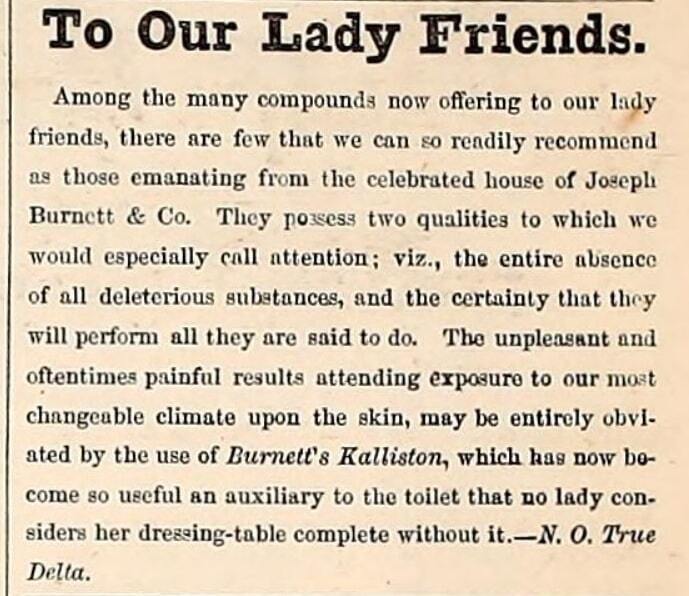Part 25
Introduction
Textually, the advertisements featured in Harper’s Weekly alongside Charles Dickens’ Great Expectations have about as much to do with each other as a Coca-Cola commercial break has to do with an episode of The West Wing – in the eyes of New Criticism, nothing. Contextually, however, these ostensibly unrelated advertisements provide the lens with which we use to view the contemporary concerns of society at the time. While the advertisements may not have been directly chosen to echo the themes explored in Great Expectations, they do offer insight into what issues were topical during the Victorian era, and therefore context for the society that Dickens was influenced by and writing for. Particularly in Part 25 of Great Expectations, which was published in Harper’s Weekly on 18 May 1861, the chapter is printed alongside various advertisements for Victorian pharmaceuticals and cosmetics, indicating a fixation with health and appearance that is reflected within the chapter itself via Pip’s preoccupation with Magwitch’s health and appearance. Given how much emphasis is placed on the subject, both within the universe of the story and in real life, I propose that the purpose of the scene is to highlight Pip’s superficiality and how that translates into classism, tying in with the larger themes of Great Expectations and thus acting as a commentary on how the health and beauty industry feeds upon class divides. Consequently, this serves to demonstrate how fiction does not exist within a vacuum and instead has a symbiotic relationship with reality.
When Pip and Magwitch have breakfast together, Pip is first and foremost focused on Magwitch’s teeth, noting that “some of his teeth had failed him since I saw him eat on the marshes, and as he turned food in his mouth, and turned his head sideways to bring his strongest fangs to bear upon it, he looked terribly like a hungry old dog” (Dickens 185), illustrating Pip’s disgust with Magwitch. While Magwitch’s table manners do indeed leave a lot to be desired, Pip’s attention is primarily centred on Magwitch’s appearance rather than his actual conduct, referring to his teeth as “fangs” and equating him to a sick dog. With how the Sands’ Sarsaparilla advertisement claims to “purify the blood, promote a vigorous circulation and thoroughly renovate the system”, the contrast with Magwitch’s physical sickliness creates the sense that Magwitch is someone who needs to be “purified”, and is thus lesser than. And yet the reason for Magwitch’s unhealthy state is due to having been brought up to be a “warmint” (Dickens 184), implying that Magwitch’s descent into criminality was an inevitability due to having been raised in poverty. The English Oxford Dictionary defines “warmint” as “an objectionable or troublesome person or persons”, so for Magwitch to have been “brought up” as one indicates that Magwitch was raised in circumstances that made becoming anything other than a criminal a nigh impossibility, meaning that his poor health and manners are something that are beyond his control, especially when his years spent as a fugitive convict would only exacerbate the issue. And yet despite this, Pip defines Magwitch by his physicality, which, as Lauren Watson argues, results in “the criminal body [becoming] a fetishistic image, an essential identity rather than a description of an act; an image with arrested physical properties that define Magwitch as morally alien yet epistemologically identifiable” (495). The sarsaparilla advertisement reflects the value of health, but by advertising health as something that can be attained monetarily, Magwitch’s lack of health becomes something that is held against him and used to demean him rather than something that is understood to be a mere consequence of his circumstances
Continuing with the idea of a Victorian value being advertised as something that can be bought, the R.G. Graham facial hair onguent advertisement aligns with Magwitch’s statement about how “disguising wigs can be bought for money, and there’s hair powder, and spectacles, and black clothes – shorts and what not” (Dickens 186), which he brings up when Pip is concerned that Magwitch will be discovered. Magwitch is under the impression that so long as he can afford to buy cosmetics and nice clothes, he can easily pass as a gentleman. But when he does attempt to disguise himself in this way, Pip notes that:
Whatever he put on, became him less (it dismally seemed to me) than what he had worn before. To my thinking there was something in him that made it hopeless to attempt to disguise him. The more I dressed him and the better I dressed him, the more he looked like the slouching fugitive on the marshes. This effect on my anxious fancy was partly referable, no doubt, to his old face and manner of growing more familiar to me: but I believe too that he dragged one of his legs as if there were still a weight of iron on it, and that from head to foot there was Convict in the very grain of the main (Dickens 188).
Magwitch, and by extension that advertisement, pushes the notion that class is something that can be bought, but as Pip reveals that Magwitch’s true nature can still be felt even when dressed nicely, this is a false notion, and therefore false advertisement on the part of the onguent. Cosmetics like the facial hair onguent promote themselves by selling the fantasy that, with enough money, one can elevate themselves to equal with nobility, as evidenced by the usage of the word “luxuriant”, which sells the image of upper class elegance. But not only does Magwitch still carry himself as if he is literally still shackled, but metaphorically he is still shackled by his impoverished upbringing that continues to weigh him down even now that he has found monetary wealth as well. This illustrates the recurring theme of “gentlemanliness” as something that cannot be bought, regardless of how wealthy one is, and is instead something that is an internal trait. As such, the onguent advertisement preys on the desire for social elevation while in reality delivering only false platitudes
The Brown’s Bronchial Troches advertisement is yet another variation on selling the illusion of social change while remaining stagnant. A troche is “a flat round tablet or lozenge, made of some medicinal substance powdered, worked into a paste with mucilage or the like, and dried” (OED) i.e. a cough drop, and cough drops, while they do provide temporary relief of throat irritation, do not actually get to the root of what is causing the irritation and/or coughing – it’s a band-aid. If we were to apply this literally to Magwitch, his voice is often described as “hoarse”, presumably due to his smoking, and so while a troche may briefly soothe his throat, the hoarseness would inevitably return due to the troche not actually curing anything. Figuratively, the incurability of Magwitch’s roughness presents the idea that “that Magwitch internalises his ‘other-ness’, unable to speak without a ‘click’ in his throat and unable to identify himself as anything other than the ‘warmit’ society objectifies him as” (Watson 496), and consequently that while pharmaceuticals and cosmetics advertised in Harper’s Weekly may provide a superficial change, on a deeper level class divisions go beyond monetary wealth, but penetrate into social upbringing as well. That is to say that while one may come into wealth later in life, unless they were raised in the upper class, they will still continue to be associated with the lower class, as seen with Magwitch.
The illusion of being able to buy one's way into prestige culminates in the Burnett’s Kalliston advertisement, which does not even specify what the product is beyond being a cosmetic. Instead, the advertisement paints itself as an unspecified necessity for “our lady friends”, claiming to be “so useful an auxiliary to the toilet that no lady considers her dressing-table complete without it”. This advertisement tactic of painting the product as a must-have heightens its desirability and gives it the impression of being a panacea, which the ambiguity of its actual function aids in highlighting. This parallels how Magwitch uses Pip as a means of vicariously achieving gentility, as by investing all his wealth in turning Pip into a gentleman, Magwitch treats Pip as a cure-all. But as with how material goods have done nothing to actually fix his health or improve his appearance, “Magwitch’s poor approximation of genteel behaviour brings home the truth of the young gentleman’s position, with the problematic genealogy of Pip’s wealth making the ambivalent genealogy of his class identity acutely conspicuous” (Watson 499). All attempts to purchase gentility fail, revealing that regardless of the ability to attain wealth, class divisions cannot be bridged as the functions of class go beyond money, but into an arbitrary code of conduct as well. The Burnett’s advertisement seems to be aware of this, hence the vagueness, as the industry relies on selling the illusion of achieving an unattainable fantasy in order to profit
Conclusions
The various advertisements featured in Harper’s Weekly are not directly connected to Great Expectations. However, as explored, the advertisements do reveal the priorities of the world that Great Expectations was made for, and in turn, Great Expectations reveals the functions behind these advertisements, for the strategies that these companies used to promote and sell their products are exactly what Dickens was commenting on in crafting his story. Magwitch, in essence, serves as the target audience for the the advertisements, and as Magwitch fails in attaining the gentility he seeks, this exposes the futility in the products advertised, for if they worked as they were supposed to, Magwitch would not be floundering around with Pip. And so even though Great Expectations and the products advertised alongside its publication are not directly related, they do demonstrate the cyclical nature of fiction and reality
Works Cited
Dickens, Charles. Great Expectations. Barnes and Noble Classics, 2005.
Watson, Lauren. “Mimics, Counterfeits and ‘Other’ Bad Copies: Forging the Currency of
Class and Colonialism in Great Expectations.” Textual Practice, vol. 25, no. 3, 2011, pp. 493–511, doi:10.1080/0950236X.2011.569178.



